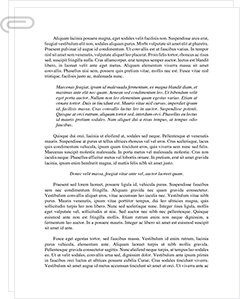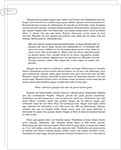 Study Document
Study Document
Infant Observation and Parents Interview Essay
Pages:4 (1348 words)
Sources:4
Document Type:Essay
Document:#94621326
Introduction
Ryon is a twelve-month-old, blond-haired, blue-eyed, White toddler. He is fair-skinned with almond-shaped eyes. I met him at a friend’s suburban residence, on 1st November, 2017, where her mom provides daycare services. I spent time between 2 p.m. and 5 p.m. at her place. I discovered Ryon seated on the living room floor. Though equipped with only a TV set and a couple of couches, the setting seemed rather comfortable and safe (Lake, 2017).
Observation
The boy seems to find no difficulty sitting up. It appears he is confident of his ability to maintain balance. He is seated feet-outwards, with legs wide out. The boy is able to lean forward till his tummy reaches the floor, though he requires a certain amount of effort in order for sitting back up. When he crawls, his hands are spread flat across the floor, with fingers made wide and feet pointed nearly directly behind the boy. When shifting from a crawl to a seated position, Ryon first raises one leg (the right one), placing the foot flat before leaning back and touching his bottom to the floor. When shifting from a crawl to a standing position, the boy goes all the way over to a couch, takes its support with one hand, leans his head back, steadies himself with right foot, and places the other hand as well on the couch prior to standing up. This activity requires a certain amount of effort. Ryon appears heavy and tall as compared to others his age and has yet to commence walking without support. (He is able to walk with the couch’s support, along its edge). His size is perhaps what deters his walking independently. The boy is sturdy, in good health, and demonstrates normal coordination. All of the above elements are considered normal by Piaget, for a toddler aged one (Lake, 2017).
Documentation
Ryon is seated on the ground surrounded by his toys. Beside him is his mom, to whom he starts handing the toys. The boy shows interest in his mom’s response to the blocks he gives her one after the other. He leans forward to pick up a block, which he passes along to her. He scrutinizes her face, mouth agape in wait for her response. His mother reads out the letter, followed by stating the block’s color. Ryon nods and moves towards the next block. When he is done with five blocks, the boy crawls to retrieve a toy car which he pushes around for some time. He then looks to observe what his mom is up to, moving the toy towards her and smiling. His mom returns the smile, asking him if the care is his. Ryon smiles and nods – he seems rather interested in how his mom reacts to him. Irrespective of whether he is near or moves off for a toy, his mom continually watches him. Ryon occasionally turns around to see whether her focus is on him or not; when she begins retrieving toys from the floor and tidying the place up, Ryon moves towards her from time to time interested in her actions. He appears to be highly dependent on her mood. If his mom smiles, he does too. When she seems distracted, he desires her focus back on him. Ryon seems to be reading and responding to his mother’s facial expressions. Overall, the mother-child relationship appears positive, with the former being highly attentive to the latter (Lake, 2017).
Reflection/Analysis
Being a learner of a kinesthetic nature, Ryon depicts a sound sense of balance, learning best through touch or personal performance of tasks. Babies, from the outset, actively construct…
Sample Source(s) Used
References
Lake, K. (2017, May 21). Sample Observation Paper for Child Development. Retrieved November 06, 2017, from https://owlcation.com/academia/Sample-Child-Observation-12-month-old
Mayo Clinic. (2016, October 13). Parenting tips: How to improve toddler behavior. Retrieved November 06, 2017, from https://www.mayoclinic.org/healthy-lifestyle/infant-and-toddler-health/in-depth/parenting-tips-for-toddlers/art-20044684?pg=1
NAEYC (n.d). Principles of child development and learning that inform developmentally appropriate practice. Retrieved November 06, 2017, from https://oldweb.naeyc.org/about/positions/dap3.asp
U.S. Department of Health and Human Services (2010). Infant/Toddler Development, Screening, and Assessment Infant/Toddler Development, Screening, and Assessment. Retrieved November 06, 2017, from https://www.google.com/url?sa=t&rct=j&q=&esrc=s&source=web&cd=1&cad=rja&uact=8&ved=0ahUKEwi-g6eIt6nXAhVHlxoKHT__A2MQFggrMAA&url=https%3A%2F%2Fwww.zerotothree.org%2Fresources%2F72-infant-and-toddler-development-screening-and-assessment&usg=AOvVaw18lE-ZFc9KdWtzeOG7CXQi
Related Documents
 Study Document
Study Document
Infant Male Circumcision Male Infant
According to this professional, circumcisions that are competently performed under local anaesthesia cause no more pain or harm than an immunisation injection. Furthermore, male circumcision ahs shown benefits such as the reduction of sexually transmitted infections such as the human pailloma virus, chancroid and syphilis. She also cites studies that indicated a reduced risk of HIV infection in males who have been circumcised. Indeed, there are quite humane ways to
 Study Document
Study Document
Parenting Styles in the Jewish Community Differentially
parenting styles in the Jewish community differentially correlate with alcohol use of Jewish College Freshmen males (18-26)? Underage and college drinking is an increasing problem for youth. This later phase of adolescence is one where pressure and a desire to act as an independent individual are overwhelming, and can convince college students to opt toward excessive alcohol usage (Bahr & Hoffman, 2012; Changalwa et al., 2012; Peckham & Lopez, 2007).
 Study Document
Study Document
Sudden Infant Death Syndrome
Sudden Infant Death Syndrome. The articles explore separate studies about the topic. The author of this work discusses various aspects of each article and their merit. There were two sources used to complete this paper. Each year in America thousands of parents walk into their infants room and discover that the child has died from Sudden Infant Death Syndrome. The tragedy shocks and baffles the medical community as it continues
 Study Document
Study Document
Teen Pregnancy and Parenting on
Of these elements, they found anxiety sensitivity to be directly linked to lower levels of educational advancement. Anxiety sensitivity mainly comprises symptoms of anxiety leading to fear due to a certain belief that anxiety has dangerous somatic, psychological, or social penalties. In one study scholars found that the basic forms of fears were the playing field for a broad spectrum of fear-stimuli and they found that these basic forms of
 Study Document
Study Document
Developmental Psychology if a Parent Approaches Child
Developmental Psychology If a parent approaches child rearing with the idea of Nativism in their mind, they might not bother to expose their children to many things early on. That is because Nativists believe a child is already hardwired with abilities, so, if the child ends up being good at music, it is because the child was born good at music, not because the child was exposed to music as a
 Study Document
Study Document
Child Care Developmental Observation of Five-Year-Old Statement
Child Care Developmental Observation of Five-Year-old Statement of Research/Observation: To observe a five-year-old female child in her natural setting to determine age appropriate developmental stages. Description of Child Being Observed: The subject is a five-year-old female: Maribel. Planning Stages: My friend has a five-year-old niece. The subject's mother was contacted and agreed to allow the observations to take place in her home and on the playground. The project was discussed and plans were made to



